The 3D Controllable Fabrication of Nanomaterials with FIB-SEM Synchronization Technology
Abstract
1. Introduction
2. Introduction of FIB Technology
2.1. FIB Optical System
2.1.1. Ion Sources
2.1.2. Ion Optical Column
2.2. FIB Operating Modes
2.2.1. Milling
2.2.2. Deposition
2.2.3. Ion Implantation
2.3. FIB Equipment with Other Systems
2.3.1. FIB-SEM Dual-Beam System
2.3.2. Multi-Beam System
3. 3D Controllable Fabrication of Nanomaterials with FIB-SEM
3.1. Conductive Materials
3.2. Semiconductive Materials
3.3. Insulative Materials
4. Conclusions and Outlook
Author Contributions
Funding
Data Availability Statement
Conflicts of Interest
References
- Tan, C.; Cao, X.; Wu, X.-J.; He, Q.; Yang, J.; Zhang, X.; Chen, J.; Zhao, W.; Han, S.; Nam, G.-H.; et al. Recent Advances in Ultrathin Two-Dimensional Nanomaterials. Chem. Rev. 2017, 117, 6225–6331. [Google Scholar] [CrossRef] [PubMed]
- Baig, N.; Kammakakam, I.; Falath, W. Nanomaterials: A review of synthesis methods, properties, recent progress, and challenges. Mater. Adv. 2021, 2, 1821–1871. [Google Scholar] [CrossRef]
- Orús, P.; Sigloch, F.; Sangiao, S.; De Teresa, J.M. Superconducting materials and devices grown by focused ion and electron beam induced deposition. Nanomaterials 2022, 12, 1367. [Google Scholar] [CrossRef] [PubMed]
- Wen, X.; Mao, R.; Hu, H. 3-D Nanofabrication of Silicon and Nanostructure Fine-Tuning via Helium Ion Implantation. Adv. Mater. Inter. 2022, 9, 210164. [Google Scholar] [CrossRef]
- Gu, P.; Zhang, W.; Zhang, G. Plasmonic Nanogaps: From Fabrications to Optical Applications. Adv. Mater. Interfaces 2018, 5, 1800648. [Google Scholar] [CrossRef]
- Tseng, A.A.; Notargiacomo, A. Nanoscale Fabrication by Nonconventional Approaches. J. Nanosci. Nanotechnol. 2005, 5, 683–702. [Google Scholar] [CrossRef]
- Melzer, J.E.; Mcleod, E. 3D Nanophotonic device fabrication using discrete components. Nanophotonics 2020, 9, 1373–1390. [Google Scholar] [CrossRef]
- Makey, G.; Galioglu, S.; Ghaffari, R.; Engin, E.D.; Yıldırım, G.; Yavuz, Ö.; Bektaş, O.; Nizam, Ü.S.; Akbulut, Ö.; Şahin, Ö.; et al. Universality of dissipative self-assembly from quantum dots to human cells. Nat. Phys. 2020, 16, 795–801. [Google Scholar] [CrossRef]
- Liu, G.; Petrosko, S.H.; Zheng, Z.; Mirkin, C.A. Evolution of Dip-Pen Nanolithography (DPN): From Molecular Patterning to Materials Discovery. Chem. Rev. 2020, 120, 6009–6047. [Google Scholar] [CrossRef]
- Erdmann, A.; Xu, D.; Evanschitzky, P.; Philipsen, V.; Luong, V.; Hendrickx, E. Characterization and mitigation of 3D mask effects in extreme ultraviolet lithography. Adv. Opt. Technol. 2017, 6, 187–201. [Google Scholar] [CrossRef]
- Liu, Z.; Liu, N.; Schroers, J. Nanofabrication through Molding. Prog. Mater. Sci. 2022, 125, 100891. [Google Scholar] [CrossRef]
- Orloff, J. High-resolution focused ion beams. Rev. Sci. Instrum. 1993, 64, 1105–1130. [Google Scholar] [CrossRef]
- Priebe, A.; Michler, J. Review of Recent Advances in Gas-Assisted Focused Ion Beam Time-of-Flight Secondary Ion Mass Spectrometry (FIB-TOF-SIMS). Materials 2023, 16, 2090. [Google Scholar] [CrossRef] [PubMed]
- Berger, C.; Dumoux, M.; Glen, T.; Yee, N.B.-y.; Mitchels, J.M.; Patáková, Z.; Darrow, M.C.; Naismith, J.H.; Grange, M. Plasma FIB milling for the determination of structures in situ. Nat. Commun. 2023, 14, 629. [Google Scholar] [CrossRef] [PubMed]
- Zhang, Z.; Wang, W.; Dong, Z.; Yang, X.; Liang, F.; Chen, X.; Wang, C.; Luo, C.; Zhang, J.; Wu, X.; et al. The Trends of In Situ Focused Ion Beam Technology: Toward Preparing Transmission Electron Microscopy Lamella and Devices at the Atomic Scale. Adv. Electron. Mater. 2022, 8, 2101401. [Google Scholar] [CrossRef]
- Orloff, J.; Utlant, M.; Swanson, L. High Resolution Focused Ion Beams: FIB and Its Applications; Kluwer Academic/Plenum Publishers: New York, NY, USA, 2003. [Google Scholar]
- Stevie, F.; Giannuzzi, L.; Prenitzer, B. The Focused Ion Beam Instrument. In Introduction to Focused Ion Beams: Instrumentation, Theory, Techniques and Practice; Springer Science & Business Media: Berlin, Germany, 2005; pp. 1–12. [Google Scholar]
- Smith, N.S.; Notte, J.A.; Steele, A.V. Advances in source technology for focused ion beam instruments. MRS Bull. 2014, 39, 329–335. [Google Scholar] [CrossRef]
- Smith, N.S.; Skoczylas, W.P.; Kellogg, S.M.; Kinion, D.E.; Tesch, P.P.; Sutherland, O.; Aanesland, A.; Boswell, R.W. High brightness inductively coupled plasma source for high current focused ion beam applications. J. Vac. Sci. Technol. B Microelectron. Nanometer Struct. Process. Meas. Phenom. 2006, 24, 2902–2906. [Google Scholar] [CrossRef]
- Liu, Z.; Sun, G.; Zhang, D.; Chen, J.; Zhong, G.; Chuan, G. Characteristics of an electron cyclotron resonance plasma source. Nucl. Tech. 2000, 23, 707–712. [Google Scholar]
- Prosa, T.J.; Larson, D.J. Modern Focused-Ion-Beam-Based Site-Specific Specimen Preparation for Atom Probe Tomography. Microsc. Microanal. 2017, 23, 194–209. [Google Scholar] [CrossRef]
- Lee, H.-T.; Kim, H.-J.; Kim, C.-S.; Gomi, K.; Taya, M.; Nomura, S.; Ahn, S.-H. Site-specific characterization of beetle horn shell with micromechanical bending test in focused ion beam system. Acta Biomater. 2017, 57, 395–403. [Google Scholar] [CrossRef]
- Li, W.-P.; Han, L.; Gu, W.-Q. Design of practical deflection field in nanometer-scale focused ion beam system. Nucl. Instrum. Methods Phys. Res. Sect. A Accel. Spectrometers Detect. Assoc. Equip. 2007, 579, 937–940. [Google Scholar] [CrossRef]
- Nee, A.Y.C. Manufacturing Engineering and Technology; Springer: Berlin/Heidelberg, Germany, 2014. [Google Scholar]
- Klingner, N.; Hlawacek, G.; Mazarov, P.; Pilz, W.; Meyer, F.; Bischoff, L. Imaging and milling resolution of light ion beams from helium ion microscopy and FIBs driven by liquid metal alloy ion sources. Beilstein J. Nanotechnol. 2020, 11, 1742–1749. [Google Scholar] [CrossRef] [PubMed]
- Belianinov, A.; Burch, M.J.; Kim, S.; Tan, S.; Hlawacek, G.; Ovchinnikova, O.S. Noble gas ion beams in materials science for future applications and devices. MRS Bull. 2017, 42, 660–666. [Google Scholar] [CrossRef]
- Stanford, M.G.; Lewis, B.B.; Mahady, K.; Fowlkes, J.D.; Rack, P.D. Review Article: Advanced nanoscale patterning and material synthesis with gas field helium and neon ion beams. J. Vac. Sci. Technol. B 2017, 35, 030802. [Google Scholar] [CrossRef]
- Bassim, N.; Scott, K.; Giannuzzi, L.A. Recent advances in focused ion beam technology and applications. MRS Bull. 2014, 39, 317–325. [Google Scholar] [CrossRef]
- Burnett, T.L.; Kelley, R.; Winiarski, B.; Contreras, L.; Daly, M.; Gholinia, A.; Burke, M.G.; Withers, P.J. Large volume serial section tomography by Xe Plasma FIB dual beam microscopy. Ultramicroscopy 2016, 161, 119–129. [Google Scholar] [CrossRef]
- Burnett, T.L.; Winiarski, B.; Kelley, R.; Zhong, X.L.; Boona, I.N.; McComb, D.W.; Mani, K.; Burke, M.G.; Withers, P.J. Xe+ Plasma FIB: 3D Microstructures from Nanometers to Hundreds of Micrometers. Microsc. Today 2016, 24, 32–39. [Google Scholar] [CrossRef]
- Nezri, E.; Orloff, J. Neutrino Oscillations v.s. Leptogenesis in SO(10) Models. J. High Energy Phys. 2003, 2003, 1–20. [Google Scholar] [CrossRef]
- Li, P.; Chen, S.; Dai, H.; Yang, Z.; Chen, Z.; Wang, Y.; Chen, Y.; Peng, W.; Shan, W.; Duan, H. Recent advances in focused ion beam nanofabrication for nanostructures and devices: Fundamentals and applications. Nanoscale 2021, 13, 1529–1565. [Google Scholar] [CrossRef]
- Kim, C.-S.; Ahn, S.-H.; Jang, D.-Y. Review: Developments in micro/nanoscale fabrication by focused ion beams. Vacuum 2012, 86, 1014–1035. [Google Scholar] [CrossRef]
- Moussaoui, H.; Laurencin, J.; Gavet, Y.; Delette, G.; Hubert, M.; Cloetens, P.; Le Bihan, T.; Debayle, J. Stochastic geometrical modeling of solid oxide cells electrodes validated on 3D reconstructions. Comput. Mater. Sci. 2018, 143, 262–276. [Google Scholar] [CrossRef]
- Shojaeefard, M.H.; Molaeimanesh, G.R.; Nazemian, M.; Moqaddari, M.R. A review on microstructure reconstruction of PEM fuel cells porous electrodes for pore scale simulation. Int. J. Hydrogen Energy 2016, 41, 20276–20293. [Google Scholar] [CrossRef]
- Sloyan, K.; Melkonyan, H.; Apostoleris, H.; Dahlem, M.S.; Chiesa, M.; Al Ghaferi, A. A review of focused ion beam applications in optical fibers. Nanotechnology 2021, 32, 472004. [Google Scholar] [CrossRef] [PubMed]
- Barroo, C.; Akey, A.J.; Bell, D.C. Atom Probe Tomography for Catalysis Applications: A Review. Appl. Sci. 2019, 9, 2721. [Google Scholar] [CrossRef]
- Nagase, T.; Gamo, K.; Kubota, T.; Mashiko, S. Maskless fabrication of nanoelectrode structures with nanogaps by using Ga focused ion beams. Microelectron. Eng. 2005, 78–79, 253–259. [Google Scholar] [CrossRef]
- Tai, K.; Li, Y.; Liu, S.; Guo, Z.; Li, C.; Du, L.; Zhao, S.; Li, X.; Liu, J. In Situ FIB-TEM-TOF-SIMS Combination Technique: Application in the Analysis of Ultra-Light and Trace Elements in Phyllosilicates. Minerals 2022, 12, 562. [Google Scholar] [CrossRef]
- Giannuzzi, L.A.; Geurts, R.; Ringnalda, J. 2 keV Ga+ FIB Milling for Reducing Amorphous Damage in Silicon. Microsc. Microanal. 2005, 11, 828–829. [Google Scholar] [CrossRef]
- Kato, N.I. Reducing focused ion beam damage to transmission electron microscopy samples. J. Electron Microsc. 2004, 53, 451–458. [Google Scholar] [CrossRef]
- Frey, L.; Lehrer, C.; Ryssel, H. Nanoscale effects in focused ion beam processing. Appl. Phys. A 2003, 76, 1017–1023. [Google Scholar] [CrossRef]
- Fernández-Pacheco, A.; Teresa, J.M.D.; Córdoba, R.; Ibarra, M.R. Metal-insulator transition in Pt-C nanowires grown by focused-ion-beam-induced deposition. Phys. Rev. B 2009, 79, 174204. [Google Scholar] [CrossRef]
- Matsui, S. Focused-ion-beam deposition for 3-D nanostructure fabrication. Nucl. Instrum. Methods Phys. Res. Sect. B: Beam Interact. Mater. At. 2007, 257, 758–764. [Google Scholar] [CrossRef]
- Lee, R.; Cecere, M. The Usage of Focused Ion Beam Induced Deposition of Gold Film in IC Device Modification and Repair. In Proceedings of the International Symposium for Testing and Failure Analysis, Santa Clara, CA, USA, 27–31 October 1997. [Google Scholar]
- Utke, I.; Michler, J.; Winkler, R.; Plank, H. Mechanical properties of 3D nanostructures obtained by focused electron/ion beam-induced deposition: A review. Micromachines 2020, 11, 397. [Google Scholar] [CrossRef] [PubMed]
- Li, W.; Zhan, X.; Song, X.; Si, S.; Chen, R.; Liu, J.; Wang, Z.; He, J.; Xiao, X. A review of recent applications of ion beam techniques on nanomaterial surface modification: Design of nanostructures and energy harvesting. Small 2019, 15, 1901820. [Google Scholar] [CrossRef] [PubMed]
- Luxmoore, I.J.; Ross, I.M.; Cullis, A.G.; Fry, P.W.; Orr, J.; Buckle, P.D.; Jefferson, J.H. Low temperature electrical characterisation of tungsten nano-wires fabricated by electron and ion beam induced chemical vapour deposition. Thin Solid Films 2007, 515, 6791–6797. [Google Scholar] [CrossRef]
- Li, Z.; Chen, F. Ion beam modification of two-dimensional materials: Characterization, properties, and applications. Appl. Phys. Rev. 2017, 4, 011103. [Google Scholar] [CrossRef]
- Moll, P.J. Focused ion beam microstructuring of quantum matter. Annu. Rev. Condens. Matter Phys. 2018, 9, 147–162. [Google Scholar] [CrossRef]
- Nanda, G.; Goswami, S.; Watanabe, K.; Taniguchi, T.; Alkemade, P.F.A. Defect Control and n-Doping of Encapsulated Graphene by Helium-Ion-Beam Irradiation. Nano Lett. 2015, 15, 4006–4012. [Google Scholar] [CrossRef]
- Phan, H.-P.; Kozeki, T.; Dinh, T.; Fujii, T.; Qamar, A.; Zhu, Y.; Namazu, T.; Nguyen, N.-T.; Dao, D.V. Piezoresistive effect of p-type silicon nanowires fabricated by a top-down process using FIB implantation and wet etching. RSC Adv. 2015, 5, 82121–82126. [Google Scholar] [CrossRef]
- Eder, K.; Bhatia, V.; Qu, J.; van Leer, B.; Dutka, M.; Cairney, J.M. A multi-ion plasma FIB study: Determining ion implantation depths of Xe, N, O and Ar in tungsten via atom probe tomography. Ultramicroscopy 2021, 228, 113334. [Google Scholar] [CrossRef]
- Mahady, K.T.; Tan, S.; Greenzweig, Y.; Raveh, A.; Rack, P.D. Simulating advanced focused ion beam nanomachining: A quantitative comparison of simulation and experimental results. Nanotechnology 2018, 29, 495301. [Google Scholar] [CrossRef]
- Deshpande, P.; Vilayurganapathy, S.; Bhat, K.N.; Ghosh, A. Study of Ga+ implantation in Si diodes: Effect on optoelectronic properties using micro-spectroscopy. Appl. Phys. A 2019, 125, 181. [Google Scholar] [CrossRef]
- Garg, V.; Mote, R.G.; Fu, J. Facile fabrication of functional 3D micro-nano architectures with focused ion beam implantation and selective chemical etching. Appl. Surf. Sci. 2020, 526, 146644. [Google Scholar] [CrossRef]
- McKenzie, W.; Quadir, M.Z.; Gass, M.H.; Munroe, P. Focused Ion beam implantation of diamond. Diam. Relat. Mater. 2011, 20, 1125–1128. [Google Scholar] [CrossRef]
- Rubanov, S.; Suvorova, A.; Popov, V.P.; Kalinin, A.A.; Pal’yanov, Y.N. Fabrication of graphitic layers in diamond using FIB implantation and high pressure high temperature annealing. Diam. Relat. Mater. 2016, 63, 143–147. [Google Scholar] [CrossRef]
- Wei, Q.; Lian, J.; Lu, W.; Wang, L. Highly ordered Ga nanodroplets on a GaAs surface formed by a focused ion beam. Phys. Rev. Lett. 2008, 100, 076103. [Google Scholar] [CrossRef] [PubMed]
- Hu, H.; Shi, B.; Breslin, C.M.; Gignac, L.; Peng, Y. A Sub-Micron Spherical Atomic Force Microscopic Tip for Surface Measurements. Langmuir 2020, 36, 7861–7867. [Google Scholar] [CrossRef] [PubMed]
- Luo, H.; Jing, R.; Cui, Y.-M.; Wang, H.-L.; Wang, R.-M. Improvement of fabrication precision of focused ion beam by introducing simultaneous electron beam. Prog. Nat. Sci. Mater. Int. 2010, 20, 111–115. [Google Scholar] [CrossRef]
- Nan, N.; Wang, J. FIB-SEM Three-Dimensional Tomography for Characterization of Carbon-Based Materials. Adv. Mater. Sci. Eng. 2019, 2019, 8680715. [Google Scholar] [CrossRef]
- Rigort, A.; Kotecha, A.; Reyntjens, S.; Mitchels, J. A Next Generation Cryo-FIB Microscope for High-Throughput Cryo-Electron Tomography. Microsc. Microanal. 2022, 28, 1250–1251. [Google Scholar] [CrossRef]
- Dumoux, M.; Glen, T.; Smith, J.L.; Ho, E.M.; Perdigão, L.M.; Pennington, A.; Klumpe, S.; Yee, N.B.; Farmer, D.A.; Lai, P.Y. Cryo-plasma FIB/SEM volume imaging of biological specimens. Elife 2023, 12, e83623. [Google Scholar] [CrossRef]
- Pillatsch, L.; Östlund, F.; Michler, J. FIBSIMS: A review of secondary ion mass spectrometry for analytical dual beam focussed ion beam instruments. Prog. Cryst. Growth Charact. Mater. 2019, 65, 1–19. [Google Scholar] [CrossRef]
- Audinot, J.-N.; Vollnhals, F.; Gratia, P.; Eswara, S.; Philipp, P.; Wirtz, T. Secondary Ion Mass Spectrometry on the Helium Ion Microscope: Methodologies for analysis of nanomaterials. Microsc. Microanal. 2018, 24, 1016–1017. [Google Scholar] [CrossRef]
- Giannuzzi, L.A.; Stevie, F.A. A review of focused ion beam milling techniques for TEM specimen preparation. Micron 1999, 30, 197–204. [Google Scholar] [CrossRef]
- Knipling, K.E.; Rowenhorst, D.J.; Fonda, R.W.; Spanos, G. Effects of focused ion beam milling on austenite stability in ferrous alloys. Mater. Charact. 2010, 61, 1–6. [Google Scholar] [CrossRef]
- Zhong, X.L.; Wade, C.A.; Withers, P.J.; Zhou, X.; Cai, C.; Haigh, S.J.; Burke, M.G. Comparing Xe+ pFIB and Ga+ FIB for TEM sample preparation of Al alloys: Minimising FIB-induced artefacts. J. Microsc. 2020, 282, 101–112. [Google Scholar] [CrossRef]
- Huh, Y.; Hong, K.J.; Shin, K.S. Amorphization Induced by Focused Ion Beam Milling in Metallic and Electronic Materials. Microsc. Microanal. 2013, 19, 33–37. [Google Scholar] [CrossRef]
- Novák, L.; Wu, M.; Wandrol, P.; Kolíbal, M.; Vystavěl, T. New approaches to in-situ heating in FIB/SEM systems. Microsc. Microanal. 2017, 23, 928–929. [Google Scholar] [CrossRef]
- Papynov, E.K.; Portnyagin, A.S.; Modin, E.B.; Mayorov, V.Y.; Shichalin, O.O.; Golikov, A.P.; Pechnikov, V.S.; Gridasova, E.A.; Tananaev, I.G.; Avramenko, V.A. A complex approach to assessing porous structure of structured ceramics obtained by SPS technique. Mater. Charact. 2018, 145, 294–302. [Google Scholar] [CrossRef]
- Minenkov, A.; Šantić, N.; Truglas, T.; Aberl, J.; Vukušić, L.; Brehm, M.; Groiss, H. Advanced preparation of plan-view specimens on a MEMS chip for in situ TEM heating experiments. MRS Bull. 2022, 47, 359–370. [Google Scholar] [CrossRef]
- Tiddia, M.; Seah, M.P.; Shard, A.G.; Mula, G.; Havelund, R.; Gilmore, I.S. Argon cluster cleaning of Ga+ FIB-milled sections of organic and hybrid materials. Surf. Interface Anal. 2018, 52, 327–334. [Google Scholar] [CrossRef]
- Singh, B.K. Sub-10 nm nanofabrication with the helium and neon ions in ORION NanoFab. In Proceedings of the International Conference Application of Accelerators in Research and Industry, Ft. Worth, TX, USA, 5–10 August 2012. [Google Scholar]
- Allen, F.I.; Velez, N.R.; Thayer, R.C.; Patel, N.H.; Jones, M.A.; Meyers, G.F.; Minor, A.M. Gallium, neon and helium focused ion beam milling of thin films demonstrated for polymeric materials: Study of implantation artifacts. Nanoscale 2019, 11, 1403–1409. [Google Scholar] [CrossRef] [PubMed]
- Zhang, W.; Zhang, Q.-H.; Zhao, M.-Q.; Theil Kuhn, L. Direct writing on graphene ‘paper’ by manipulating electrons as ‘invisible ink’. Nanotechnology 2013, 24, 275301. [Google Scholar] [CrossRef] [PubMed]
- Kollmann, H.; Piao, X.; Esmann, M.; Becker, S.F.; Hou, D.; Huynh, C.; Kautschor, L.-O.; Bosker, G.; Vieker, H.; Beyer, A.; et al. Toward plasmonics with nanometer precision: Nonlinear optics of helium-ion milled gold nanoantennas. Nano Lett. 2014, 14, 4778–4784. [Google Scholar] [CrossRef] [PubMed]
- Kumar, R.; Chauhan, M.; Moinuddin, M.G.; Sharma, S.K.; Gonsalves, K.E. Development of Nickel-based Negative Tone Metal Oxide Cluster Resists for sub-10 nm Electron Beam and Helium Ion Beam Lithography. ACS Appl. Mater. Interfaces 2020, 12, 19616–19624. [Google Scholar] [CrossRef] [PubMed]
- Yoon, H.-S.; Kim, C.-S.; Lee, H.-T.; Ahn, S.-H. Advanced scanning paths for focused ion beam milling. Vacuum 2017, 143, 40–49. [Google Scholar] [CrossRef]
- Ziegler, J.F.; Ziegler, M.D.; Biersack, J.P. SRIM—The stopping and range of ions in matter (2010). Nucl. Instrum. Meth. B 2010, 268, 1818–1823. [Google Scholar] [CrossRef]
- Drobny, J.; Curreli, D. F-TRIDYN simulations of tungsten self-sputtering and applications to coupling plasma and material codes. Comput. Mater. Sci. 2018, 149, 301–306. [Google Scholar] [CrossRef]
- Muller, W.; Eckstein, W. Tridyn—A TRIM simulation code including dynamic composition changes. Nucl. Instrum. Meth. B 1984, 2, 814–818. [Google Scholar] [CrossRef]
- von Toussaint, U.; Mutzke, A.; Manhard, A. Sputtering of rough surfaces: A 3D simulation study. Phys. Scr. 2017, 2017, 014056. [Google Scholar] [CrossRef]
- Timilsina, R.; Smith, D.A.; Rack, P.D. A comparison of neon versus helium ion beam induced deposition via Monte Carlo simulations. Nanotechnology 2013, 24, 115302. [Google Scholar] [CrossRef]
- Mahady, K.; Tan, S.; Greenzweig, Y.; Livengood, R.; Raveh, A.; Fowlkes, J.D.; Rack, P. Monte Carlo simulations of secondary electron emission due to ion beam milling. J. Vac. Sci. Technol. B 2017, 35, 041805. [Google Scholar] [CrossRef]
- Mahady, K.; Tan, S.; Greenzweig, Y.; Livengood, R.; Raveh, A.; Rack, P. Monte Carlo simulations of nanoscale Ne+ ion beam sputtering: Investigating the influence of surface effects, interstitial formation, and the nanostructural evolution. Nanotechnology 2016, 28, 045305. [Google Scholar] [CrossRef]
- Mahady, K.T.; Tan, S.; Greenzweig, Y.; Raveh, A.; Rack, P.D. Monte Carlo simulation of nanoscale material focused ion beam gas-assisted etching: Ga+ and Ne+ etching of SiO2 in the presence of a XeF2 precursor gas. Nanoscale Adv. 2019, 1, 3584–3596. [Google Scholar] [CrossRef] [PubMed]
- Timilsina, R.; Rack, P.D. Monte Carlo simulations of nanoscale focused neon ion beam sputtering. Nanotechnology 2013, 24, 495303. [Google Scholar] [CrossRef] [PubMed]
- Buchnev, O.; Grant-Jacob, J.A.; Eason, R.W.; Zheludev, N.I.; Mills, B.; MacDonald, K.F. Deep-Learning-Assisted Focused Ion Beam Nanofabrication. Nano Lett. 2022, 22, 2734–2739. [Google Scholar] [CrossRef]
- Wu, H.M.; Stern, L.A.; Chen, J.H.; Huth, M.; Schwalb, C.H.; Winhold, M.; Porrati, F.; González, C.M.; Timilsina, R.; Rack, P.D. Synthesis of nanowires via helium and neon focused ion beam induced deposition with the gas field ion microscope. Nanotechnology 2013, 24, 175302. [Google Scholar] [CrossRef]
- Shukla, N.; Tripathi, S.K.; Banerjee, A.; Ramana, A.S.V.; Rajput, N.S.; Kulkarni, V.N. Study of temperature rise during focused Ga ion beam irradiation using nanothermo-probe. Appl. Surf. Sci. 2009, 256, 475–479. [Google Scholar] [CrossRef]
- Cui, A.; Li, W.; Shen, T.H.; Yao, Y.; Fenton, J.C.; Peng, Y.; Liu, Z.; Zhang, J.; Gu, C. Thermally Induced Shape Modification of Free-standing Nanostructures for Advanced Functionalities. Sci. Rep. 2013, 3, 2429. [Google Scholar] [CrossRef] [PubMed]
- Cui, A.; Liu, Z.; Dong, H.; Wang, Y.; Zhen, Y.; Li, W.; Li, J.; Gu, C.; Hu, W. Single grain boundary break junction for suspended nanogap electrodes with gapwidth down to 1–2 nm by focused ion beam milling. Adv. Mater. 2015, 27, 3002–3006. [Google Scholar] [CrossRef]
- Hinum-Wagner, J.; Kuhness, D.; Kothleitner, G.; Winkler, R.; Plank, H. FEBID 3D-Nanoprinting at Low Substrate Temperatures: Pushing the Speed While Keeping the Quality. Nanomaterials 2021, 11, 1527. [Google Scholar] [CrossRef]
- Esposito, M.; Tasco, V.; Todisco, F.; Benedetti, A.; Sanvitto, D.; Passaseo, A. Three Dimensional Chiral Metamaterial Nanospirals in the Visible Range by Vertically Compensated Focused Ion Beam Induced-Deposition. Adv. Opt. Mater. 2014, 2, 154–161. [Google Scholar] [CrossRef]
- Esposito, M.; Tasco, V.; Cuscunà, M.; Todisco, F.; Benedetti, A.; Tarantini, I.; De Giorgi, M.; Sanvitto, D.; Passaseo, A. Nanoscale 3D Chiral Plasmonic Helices with Circular Dichroism at Visible Frequencies. ACS Photonics 2015, 2, 105–114. [Google Scholar] [CrossRef]
- Córdoba, R.; Mailly, D.; Rezaev, R.; Smirnova, E.; Schmidt, O.G.; Fomin, V.M.; Zeitler, U.; Guillamón, I.; Suderow, H.; de Teresa, J.M. Three-Dimensional Superconducting Nanohelices Grown by He+-Focused-Ion-Beam Direct Writing. Nano Lett. 2019, 19, 8597–8604. [Google Scholar] [CrossRef]
- Chen, S.; Chen, J.; Zhang, X.; Li, Z.-Y.; Li, J. Kirigami/origami: Unfolding the new regime of advanced 3D microfabrication/nanofabrication with “folding”. Light Sci. Appl. 2020, 9, 75. [Google Scholar] [CrossRef] [PubMed]
- Liu, Z.; Li, J.; Liu, Z.; Li, W.; Li, J.; Gu, C.; Li, Z. Fano resonance Rabi splitting of surface plasmons. Sci. Rep. 2017, 7, 8010. [Google Scholar] [CrossRef] [PubMed]
- Liu, Z.; Du, H.; Li, J.; Lu, L.; Li, Z.-Y.; Fang, N.X. Nano-kirigami with giant optical chirality. Sci. Adv. 2018, 4, eaat4436. [Google Scholar] [CrossRef] [PubMed]
- Garoli, D.; Zilio, P.; De Angelis, F.; Gorodetski, Y. Helicity locking of chiral light emitted from a plasmonic nanotaper. Nanoscale 2017, 9, 6965–6969. [Google Scholar] [CrossRef]
- Chen, S.-S.; Liu, X.; Liu, Z.-G.; Li, J.-F. Focused ion beam based nano-kirigami/origami for three-dimensional micro/nanomanufacturing and photonic applications. Acta Phys. Sin. 2019, 68, 248101. [Google Scholar] [CrossRef]
- Zhao, L.; Li, C.; Xu, J.; Wu, W. Fabrication of suspended periodic nanostructure by focused ion beam induced material migration and Rayleigh-Plateau instability. In Proceedings of the 13th IEEE International Conference on Nanotechnology, Beijing, China, 5–8 August 2013. [Google Scholar]
- Liu, Z.; Du, H.; Li, Z.-Y.; Fang, N.X.; Li, J. Invited Article: Nano-kirigami metasurfaces by focused-ion-beam induced close-loop transformation. APL Photonics 2018, 3, 100803. [Google Scholar] [CrossRef]
- Chalapat, K.; Chekurov, N.; Li, J.; Paraoanu, G. Ion-beam assisted self-assembly of metallic nanostructures. Nucl. Instrum. Methods Phys. Res. Sect. B Beam Interact. Mater. At. 2012, 272, 202–205. [Google Scholar] [CrossRef]
- Okada, M.; Nakamatsu, K.-i.; Kanda, K.; Haruyama, Y.; Kometani, R.; Kaito, T.; Matsui, S. Examination of focused-ion-beam repair resolution for UV-nanoimprint templates. Jpn. J. Appl. Phys. 2008, 47, 5160. [Google Scholar] [CrossRef]
- Gorkunov, M.V.; Rogov, O.Y.; Kondratov, A.V.; Artemov, V.V.; Gainutdinov, R.V.; Ezhov, A.A. Chiral visible light metasurface patterned in monocrystalline silicon by focused ion beam. Sci. Rep. 2018, 8, 11623. [Google Scholar] [CrossRef] [PubMed]
- Drezner, Y.; Greenzweig, Y.; Tan, S.; Livengood, R.H.; Raveh, A. High resolution TEM analysis of focused ion beam amorphized regions in single crystal silicon—A complementary materials analysis of the teardrop method. J. Vac. Sci. Technol. B 2017, 35, 011801. [Google Scholar] [CrossRef]
- Liu, Z.; Du, S.; Cui, A.; Li, Z.; Fan, Y.; Chen, S.; Li, W.; Li, J.; Gu, C. High-Quality-Factor Mid-Infrared Toroidal Excitation in Folded 3D Metamaterials. Adv. Mater. 2017, 29, 1606298. [Google Scholar] [CrossRef]
- Celebi, K.; Buchheim, J.; Wyss, R.M.; Droudian, A.; Gasser, P.; Shorubalko, I.; Kye, J.-I.; Lee, C.; Park, H.G. Ultimate permeation across atomically thin porous graphene. Science 2014, 344, 289–292. [Google Scholar] [CrossRef]
- López, J.J.; Ambrosio, A.; Dai, S.; Huynh, C.; Bell, D.C.; Lin, X.; Rivera, N.; Huang, S.; Ma, Q.; Eyhusen, S. Large photothermal effect in sub-40 nm h-BN nanostructures patterned via high-resolution ion beam. Small 2018, 14, 1800072. [Google Scholar] [CrossRef] [PubMed]
- Winston, D.; Manfrinato, V.R.; Nicaise, S.M.; Cheong, L.L.; Duan, H.; Ferranti, D.; Marshman, J.; McVey, S.; Stern, L.; Notte, J.; et al. Neon ion beam lithography (NIBL). Nano Lett. 2011, 11, 4343–4347. [Google Scholar] [CrossRef] [PubMed]
- Li, W.; Liao, L.; Xiao, X.; Zhao, X.; Dai, Z.; Guo, S.; Wu, W.; Shi, Y.; Xu, J.; Ren, F.; et al. Modulating the threshold voltage of oxide nanowire field-effect transistors by a Ga+ ion beam. Nano Res. 2014, 7, 1691–1698. [Google Scholar] [CrossRef]
- Kim, T.-Y.; Cho, K.; Park, W.; Park, J.; Song, Y.; Hong, S.; Hong, W.-K.; Lee, T. Irradiation effects of high-energy proton beams on MoS2 field effect transistors. ACS Nano 2014, 8, 2774–2781. [Google Scholar] [CrossRef]
- Li, C.; Ding, K.; Wu, W.; Xu, J. Ultra-fine nanofabrication by hybrid of energetic ion induced fluidization and stress. In Proceedings of the IEEE 24th International Conference on Micro Electro Mechanical Systems, Cancun, Mexico, 23–27 January 2011. [Google Scholar]
- Liao, Z.-M.; Lu, Y.; Wu, H.-C.; Bie, Y.-Q.; Zhou, Y.-B.; Yu, D.-P. Improved performance of ZnO nanowire field-effect transistors via focused ion beam treatment. Nanotechnology 2011, 22, 375201. [Google Scholar] [CrossRef]
- Liu, Y.; Gao, Z.; Tan, Y.; Chen, F. Enhancement of out-of-plane charge transport in a vertically stacked two-dimensional heterostructure using point defects. ACS Nano 2018, 12, 10529–10536. [Google Scholar] [CrossRef]
- Jamaludin, F.S.; Mohd Sabri, M.F.; Said, S.M. Controlling parameters of focused ion beam (FIB) on high aspect ratio micro holes milling. Microsyst. Technol. 2013, 19, 1873–1888. [Google Scholar] [CrossRef]
- Ishikawa, O.; Nitta, N.; Taniwaki, M. Fabrication of high aspect ratio nanocell lattices by ion beam irradiation. Appl. Surf. Sci. 2016, 385, 515–520. [Google Scholar] [CrossRef]
- Bassim, N.D.; De Gregorio, B.T.; Kilcoyne, A.L.D.; Scott, K.; Chou, T.; Wirick, S.; Cody, G.; Stroud, R.M. Minimizing damage during FIB sample preparation of soft materials. J. Microsc. 2012, 245, 288–301. [Google Scholar] [CrossRef]
- Kim, S.; Park, M.J.; Balsara, N.P.; Liu, G.; Minor, A.M. Minimization of focused ion beam damage in nanostructured polymer thin films. Ultramicroscopy 2011, 111, 191–199. [Google Scholar] [CrossRef]
- Guan, L.; Peng, K.; Yang, Y.; Qiu, X.; Wang, C. The nanofabrication of polydimethylsiloxane using a focused ion beam. Nanotechnology 2009, 20, 145301. [Google Scholar] [CrossRef] [PubMed]
- Mancini, A.; Giliberti, V.; Alabastri, A.; Calandrini, E.; de Angelis, F.; Garoli, D.; Ortolani, M. Thermoplasmonic Effect of Surface Enhanced Infrared Absorption in Vertical Nanoantenna Arrays. J. Phys. Chem. C 2018, 122, 13072–13081. [Google Scholar] [CrossRef]
- Orthacker, A.; Schmied, R.; Chernev, B.; Fröch, J.E.; Winkler, R.; Hobisch, J.; Trimmel, G.; Plank, H. Chemical degradation and morphological instabilities during focused ion beam prototyping of polymers. Phys. Chem. Chem. Phys. 2014, 16, 1658–1666. [Google Scholar] [CrossRef]
- Her, E.K.; Chung, H.-S.; Moon, M.W.; Oh, K.H. An angled nano-tunnel fabricated on poly(methyl methacrylate) by a focused ion beam. Nanotechnology 2009, 20, 285301. [Google Scholar] [CrossRef]
- Gorelick, S.; Vila-Comamala, J.; Guzenko, V.; Mokso, R.; Stampanoni, M.; David, C. Direct e-beam writing of high aspect ratio nanostructures in PMMA: A tool for diffractive X-ray optics fabrication. Microelectron. Eng. 2010, 87, 1052–1056. [Google Scholar] [CrossRef]
- Romagnoli, P.; Maeda, M.; Ward, J.M.; Truong, V.G.; Nic Chormaic, S. Fabrication of optical nanofibre-based cavities using focussed ion-beam milling: A review. Appl. Phys. B 2020, 126, 111. [Google Scholar] [CrossRef]
- Li, W.; Du, J.; Truong, V.G.; Chormaic, S.N. Optical nanofiber-based cavity induced by periodic air-nanohole arrays. Appl. Phys. Lett. 2017, 110, 253102. [Google Scholar] [CrossRef]
- Kim, H.-M.; Uh, M.; Jeong, D.H.; Lee, H.-Y.; Park, J.-H.; Lee, S.-K. Localized surface plasmon resonance biosensor using nanopatterned gold particles on the surface of an optical fiber. Sensors Actuators B: Chem. 2019, 280, 183–191. [Google Scholar] [CrossRef]
- Reznikov, N.; Shahar, R.; Weiner, S. Bone hierarchical structure in three dimensions. Acta Biomater. 2014, 10, 3815–3826. [Google Scholar] [CrossRef]
- Narayan, K.; Subramaniam, S. Focused ion beams in biology. Nat. Meth. 2015, 12, 1021–1031. [Google Scholar] [CrossRef] [PubMed]
- Heymann, J.A.; Hayles, M.; Gestmann, I.; Giannuzzi, L.A.; Lich, B.; Subramaniam, S. Site-specific 3D imaging of cells and tissues with a dual beam microscope. J. Struct. Biol. 2006, 155, 63–73. [Google Scholar] [CrossRef]
- Trebichalská, Z.; Javůrek, J.; Tatíčková, M.; Kyjovská, D.; Kloudová, S.; Otevřel, P.; Hampl, A.; Holubcová, Z. High-Resolution 3D Reconstruction of Human Oocytes Using Focused Ion Beam Scanning Electron Microscopy. Front. Cell Dev. Biol. 2021, 9, 755740. [Google Scholar] [CrossRef]
- Xu, C.S.; Pang, S.; Hayworth, K.J.; Hess, H.F. Transforming FIB-SEM Systems for Large-Volume Connectomics and Cell Biology. In Volume Microscopy: Multiscale Imaging with Photons, Electrons, and Ions; Springer: New York, NY, USA, 2020; pp. 221–243. [Google Scholar]
- Röding, M.; Fager, C.; Olsson, A.; von Corswant, C.; Olsson, E.; Lorén, N. Three-dimensional reconstruction of porous polymer films from FIB-SEM nanotomography data using random forests. J. Microsc. 2020, 281, 76–86. [Google Scholar] [CrossRef]
- Lee, C.; Proust, G.; Alici, G.; Spinks, G.; Cairney, J.M. Three-dimensional nanofabrication of polystyrene by focused ion beam. J. Microsc. 2012, 248, 129–139. [Google Scholar] [CrossRef]

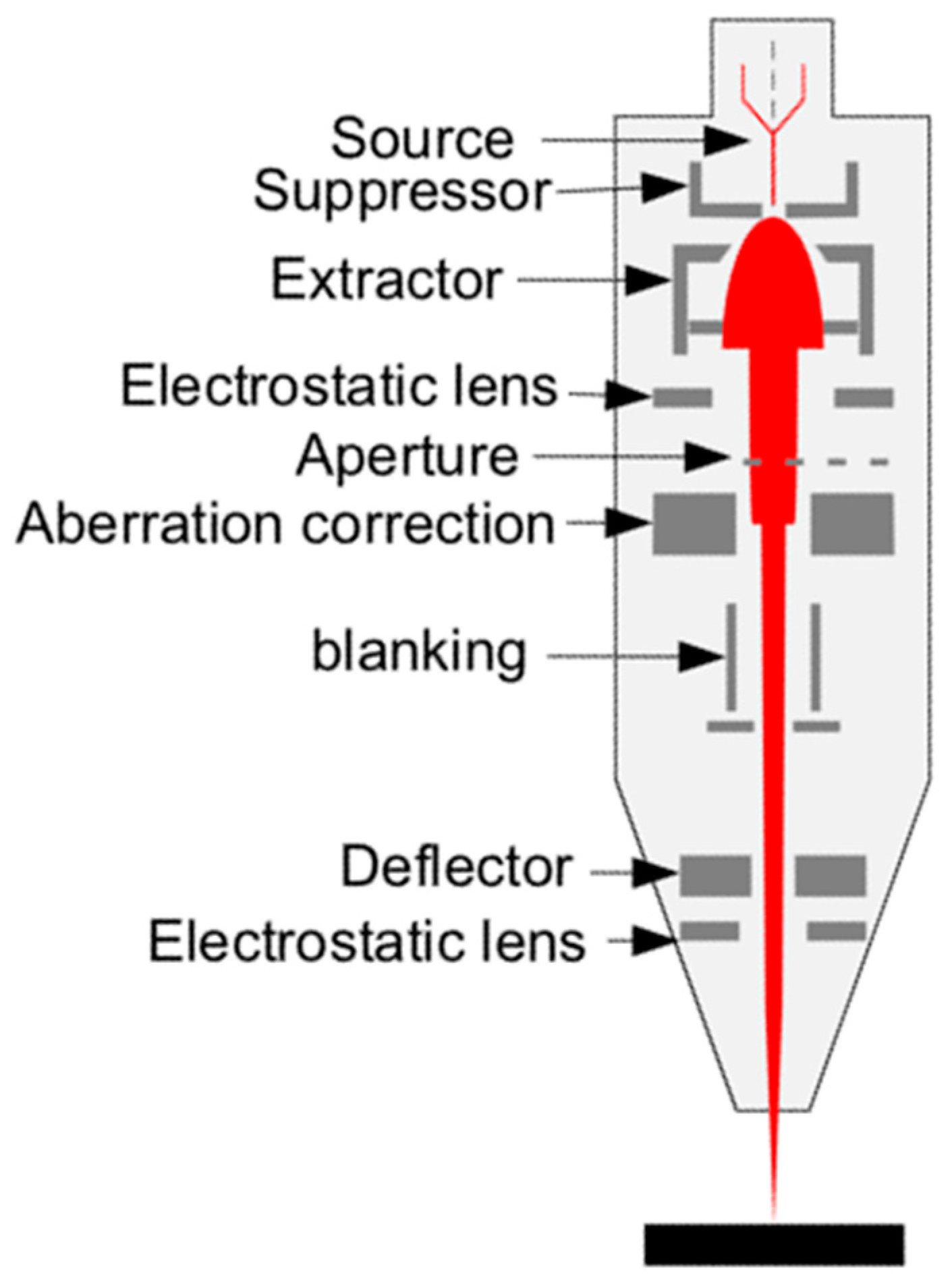
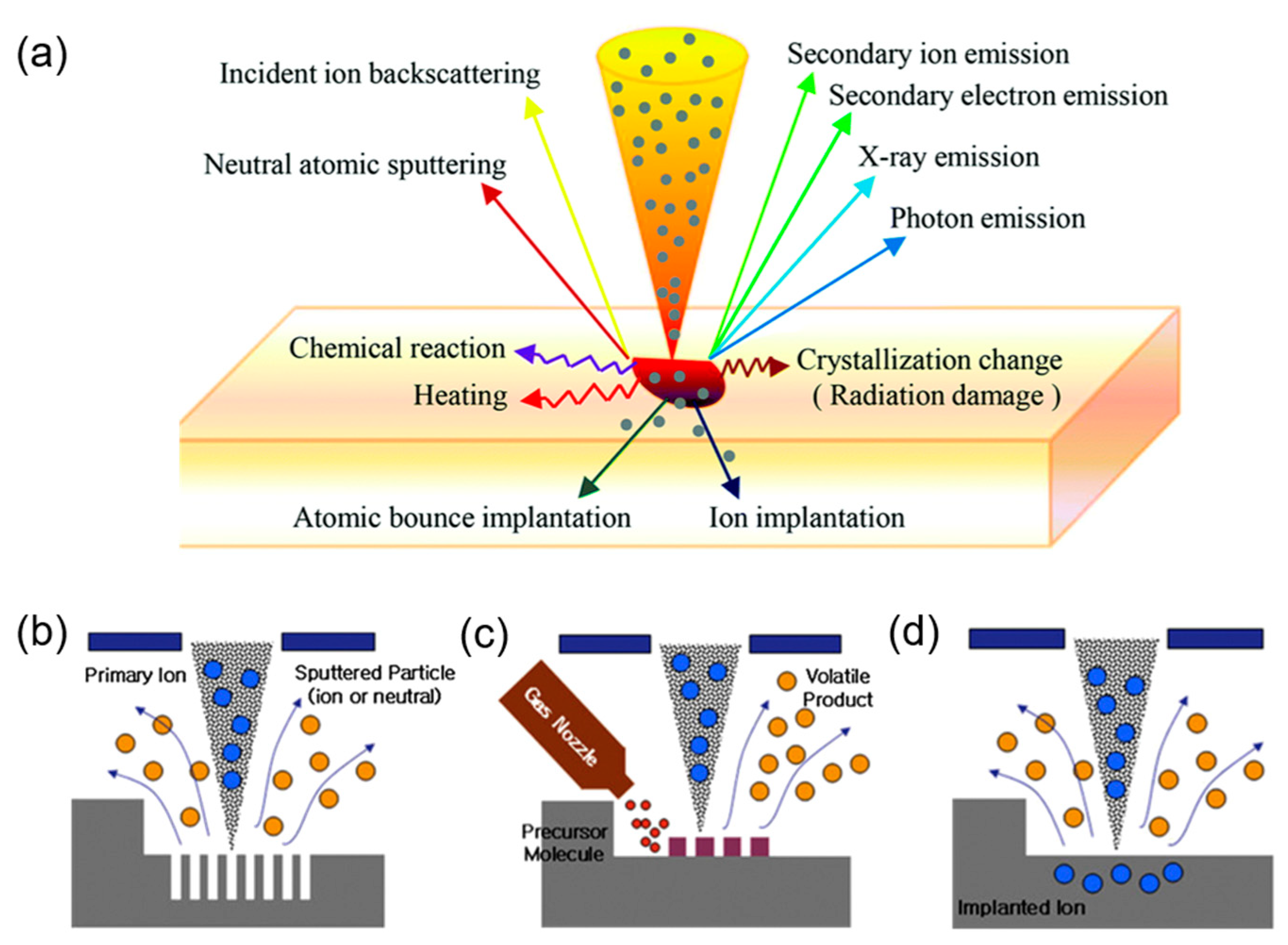
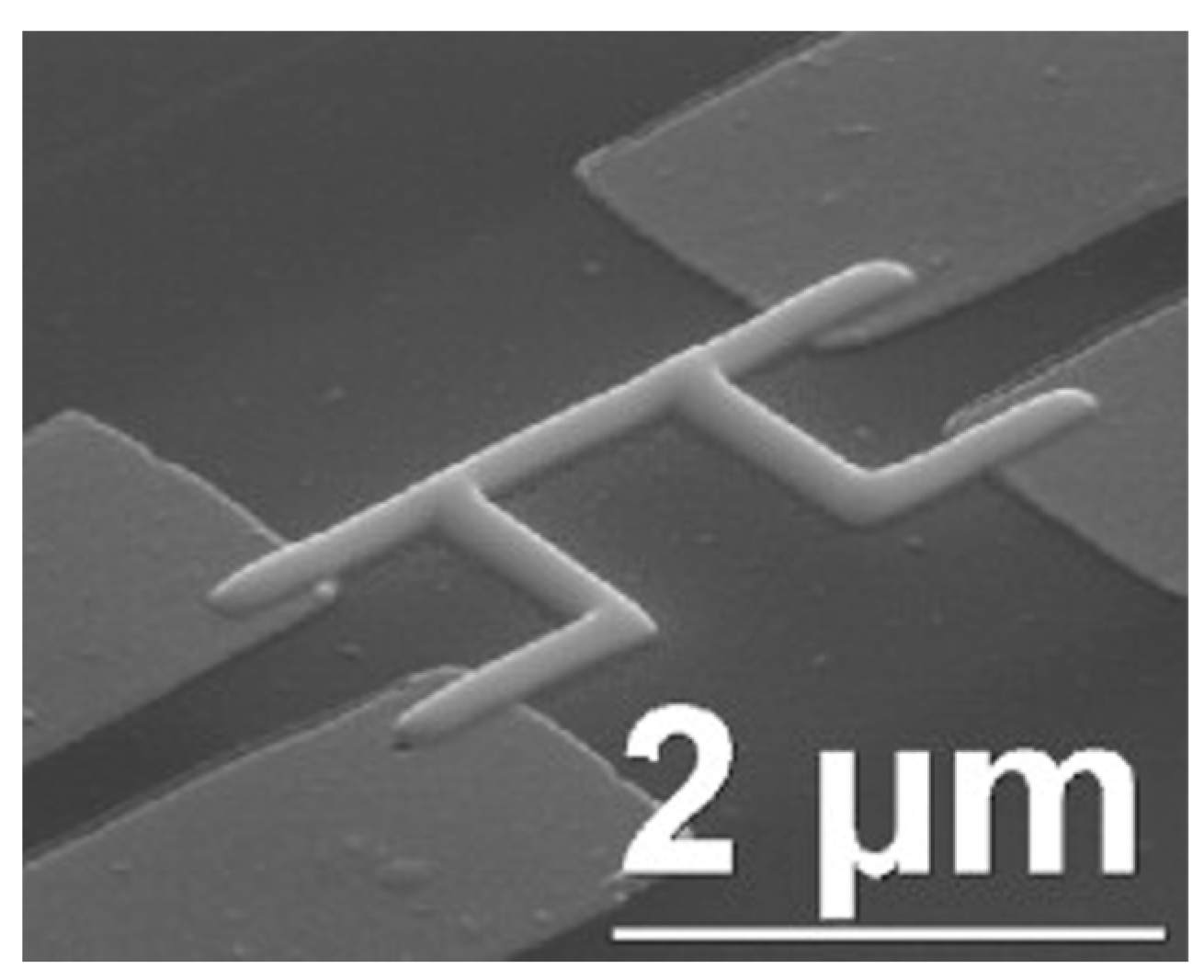
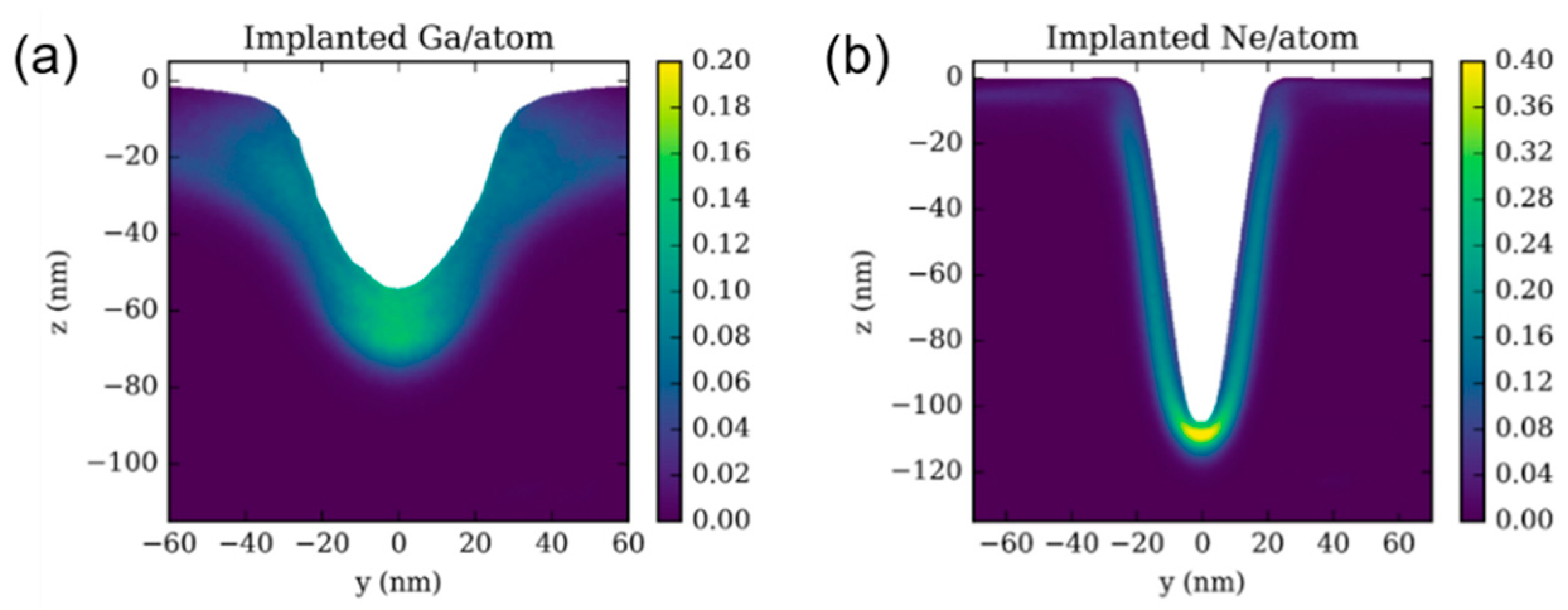


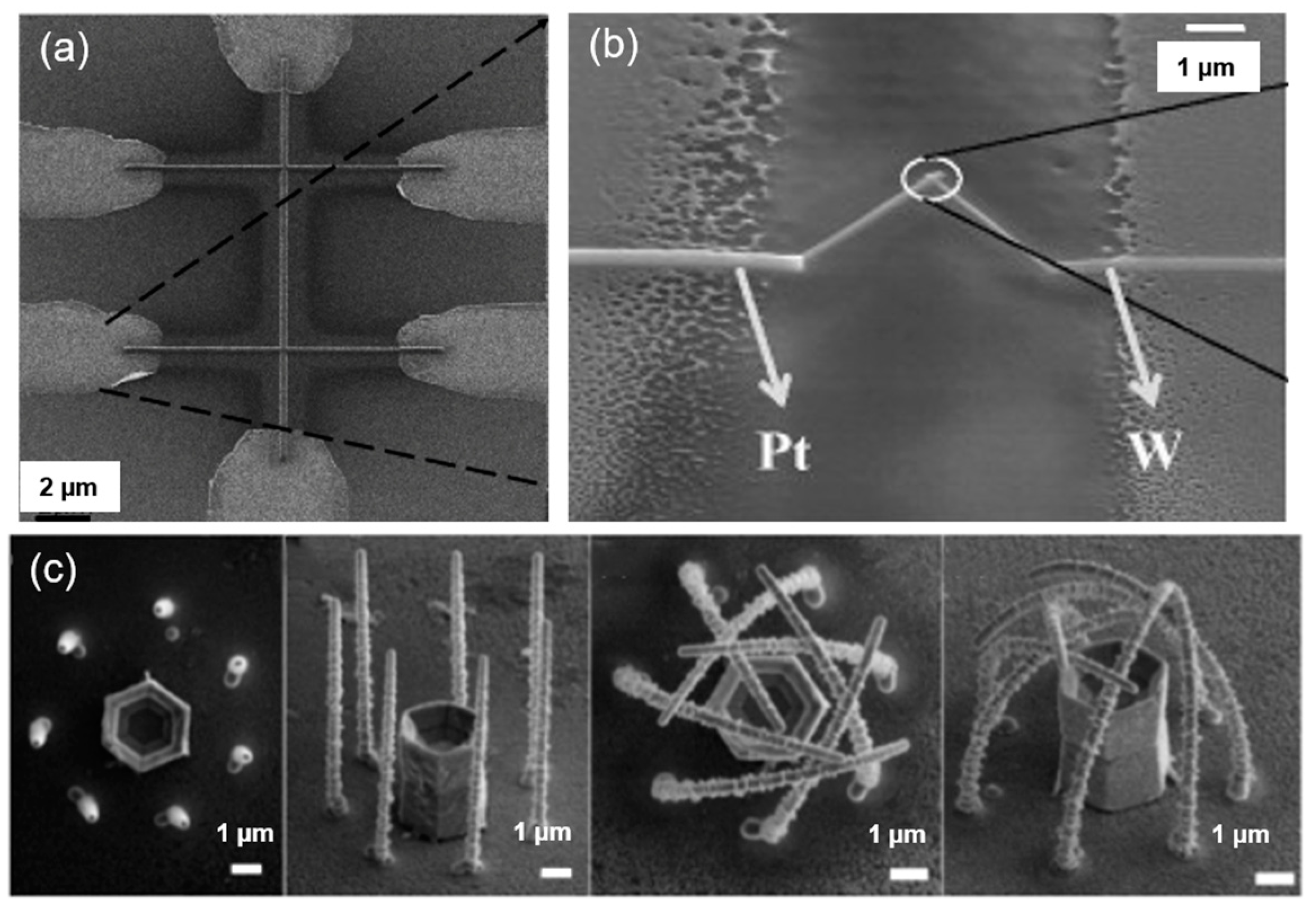
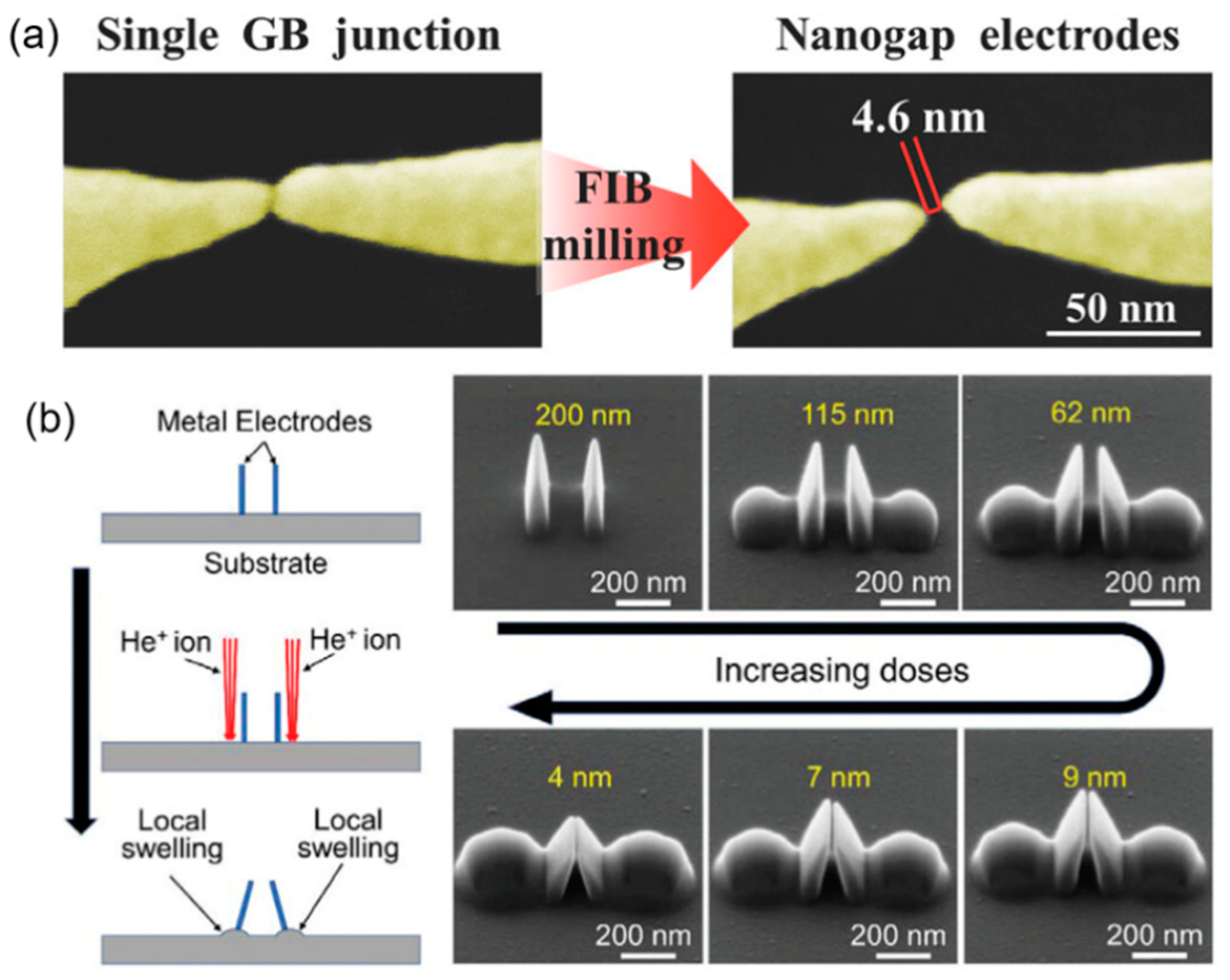
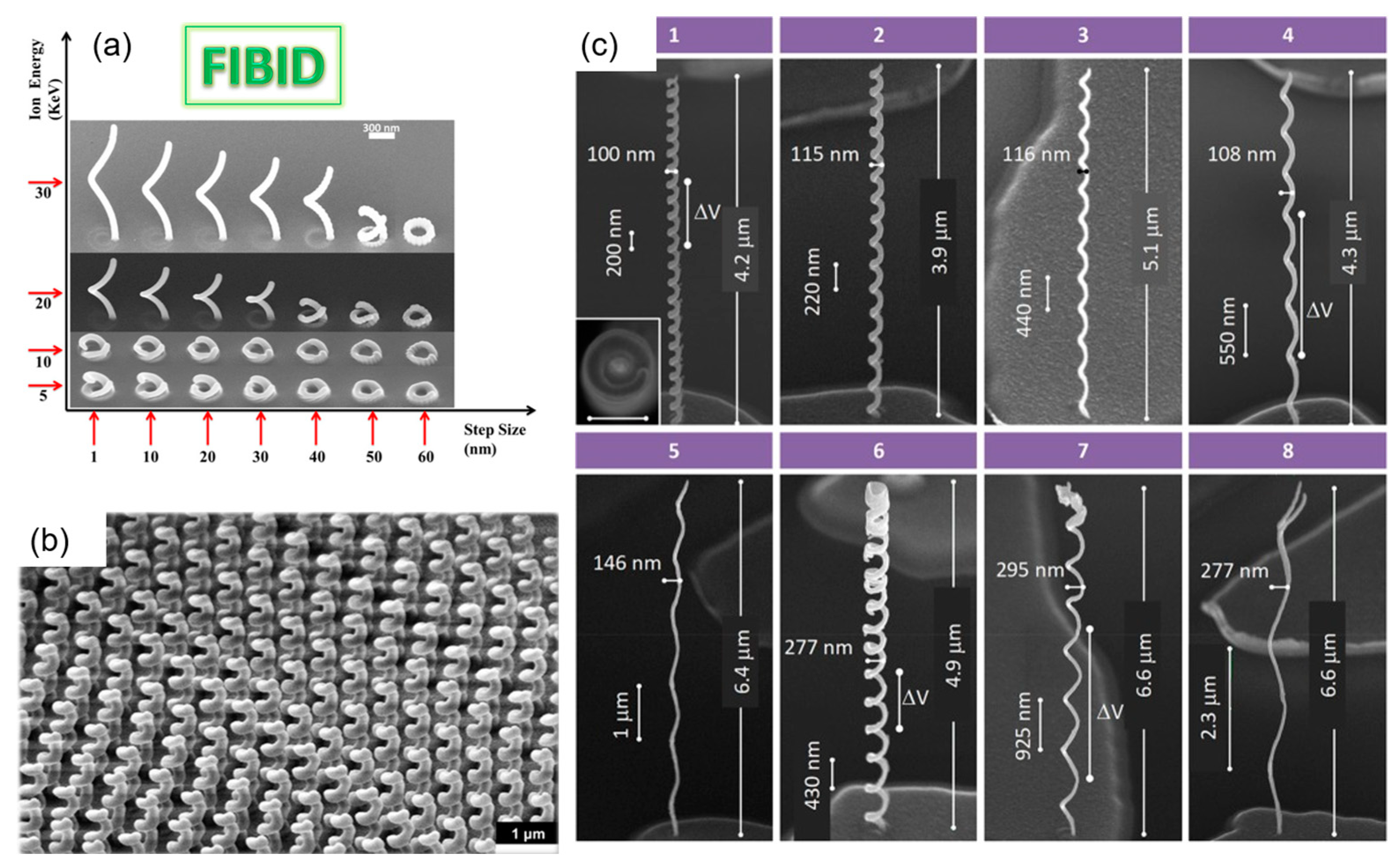
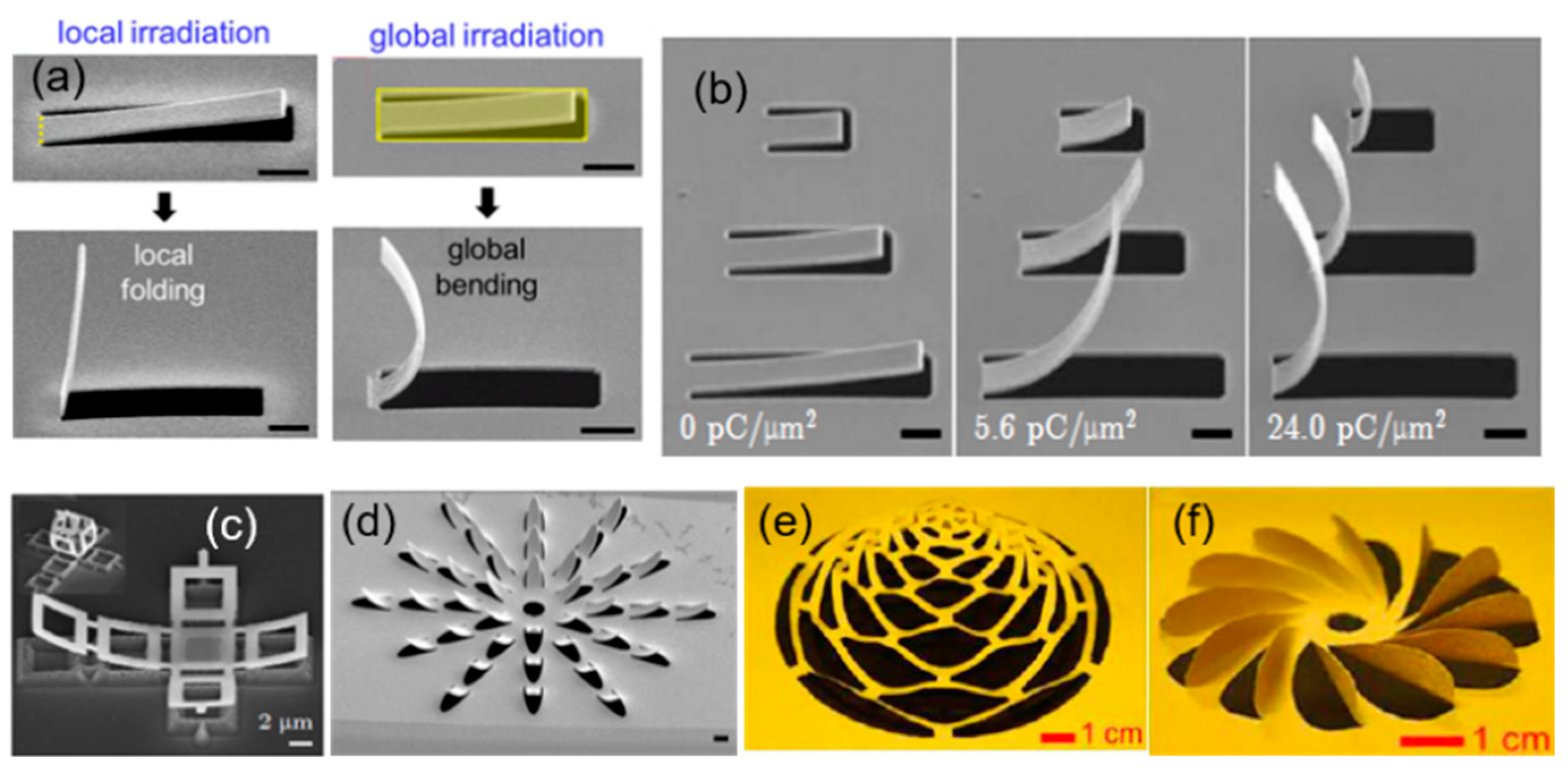
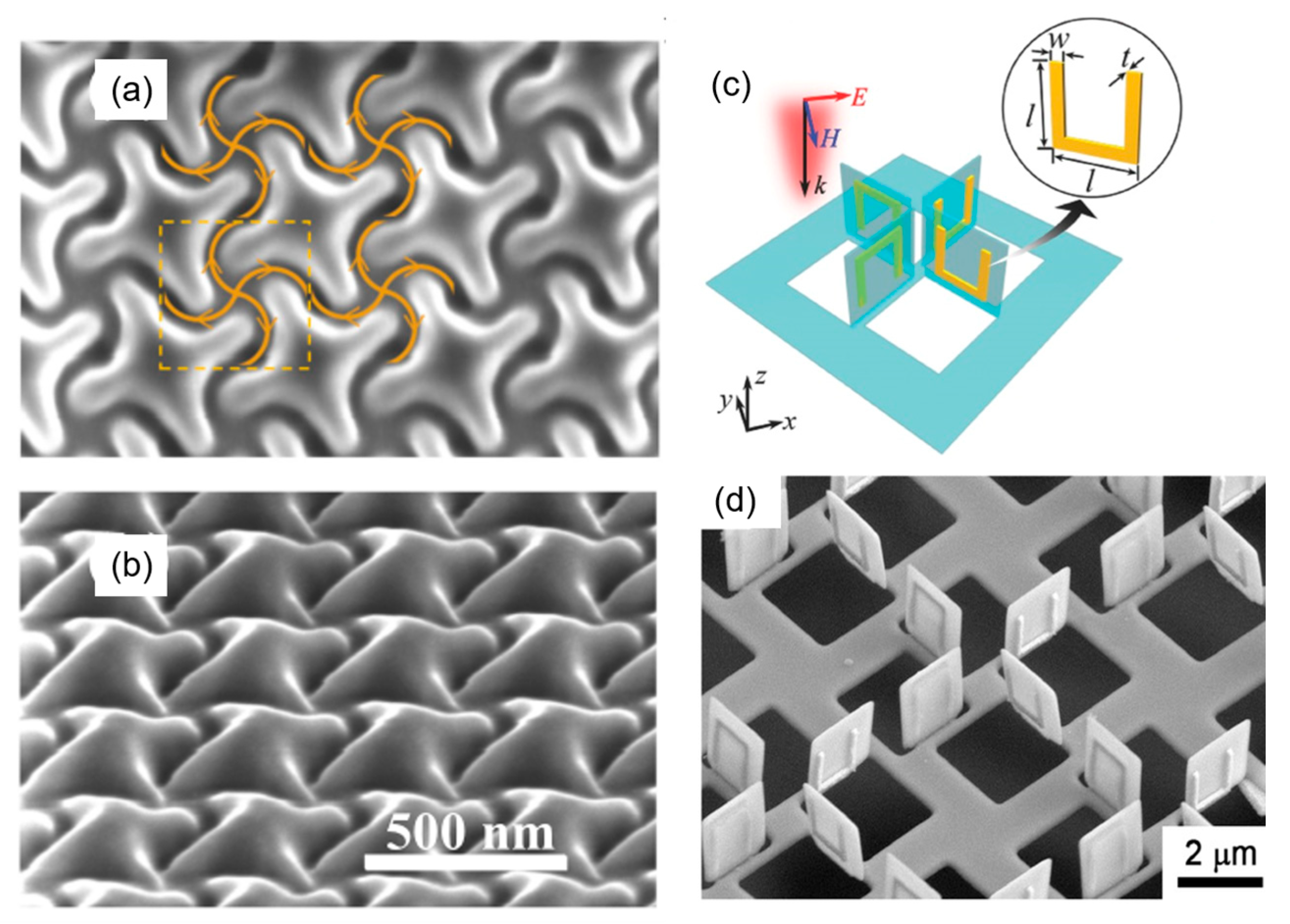
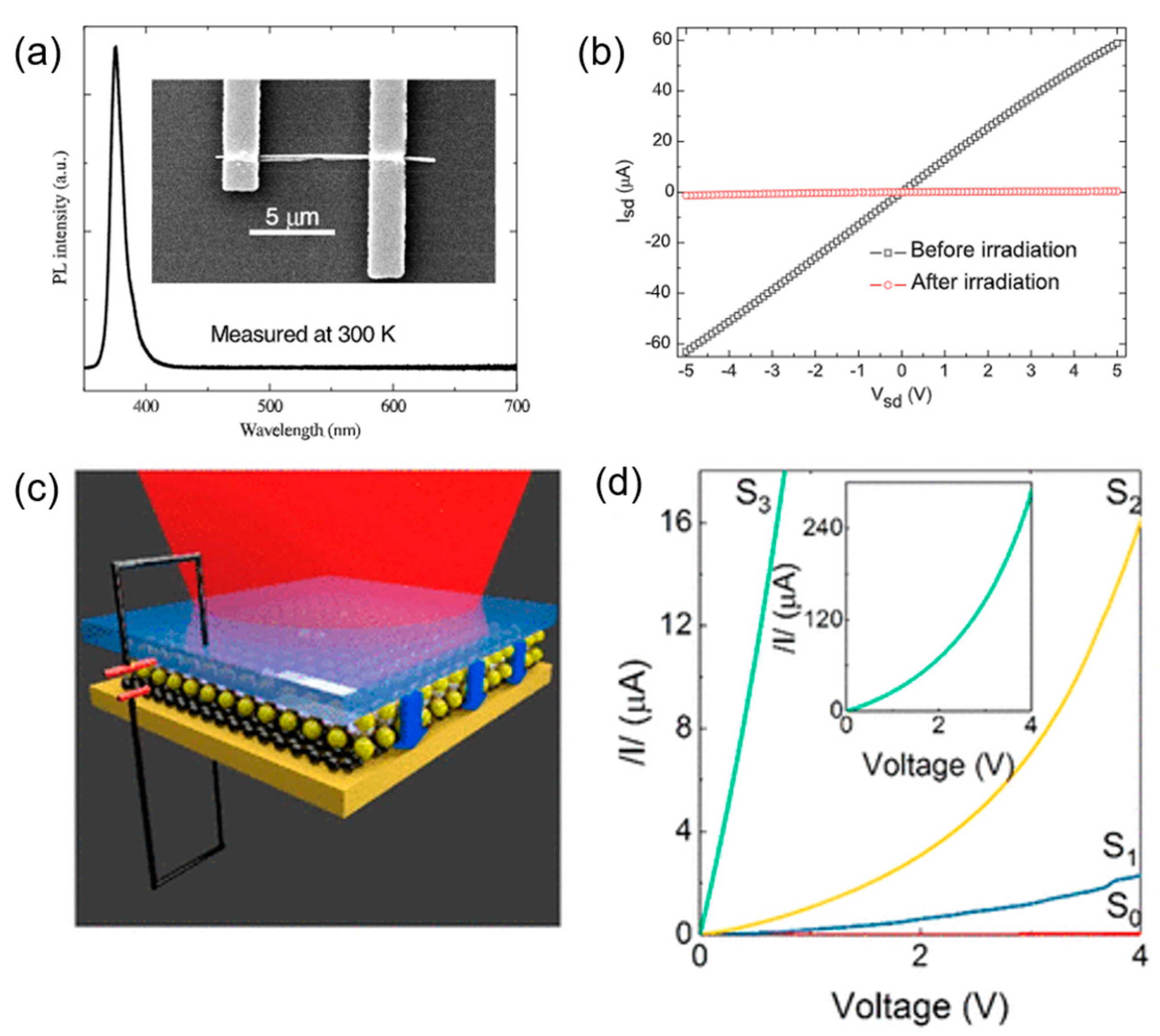
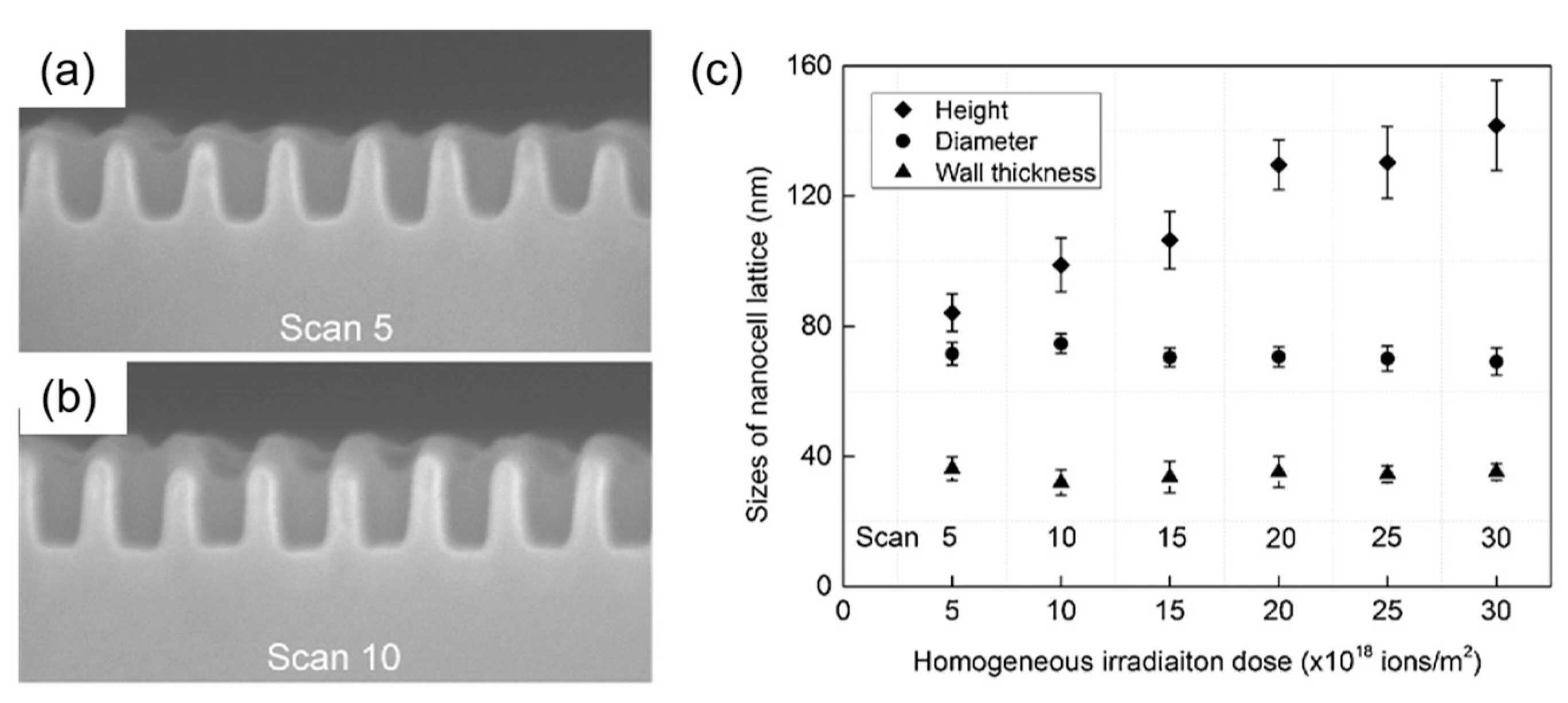


| Ion Source Type | Main Ion Species | Source Spot (nm) | Optional Ion Species | ||
|---|---|---|---|---|---|
| LMIS | Ga+ | 5 | 50–100 | B, Be, Sn, Au … | |
| GFIS | He+ | 1 | Ne+ | ||
| Plasma | Xe+ (ICP) | 5 | >400 nm | (ICP), He+ (ICP) |
| Materials | Structures | Sources | Applications | References |
|---|---|---|---|---|
| Porous-based graphene | Nanoporous | Ga+, He+ | Membrane separation technology | [111] |
| h-BN | Nanograting | He+, Ne+ | Nanomechanical switches driven by light | [112] |
| HSQ/Si | Nanograting | Ne+ | Chemical sensing, magnetic storage | [113] |
| SnO2/In2O3 | Nanowires | Ga+ | Field-effect transistors (FET) | [114] |
| GaN | Micropillar | Ar+ | FET | [115] |
| Si3N4 | Nanostrings | Ga+ | Nanogap electron | [116] |
Disclaimer/Publisher’s Note: The statements, opinions and data contained in all publications are solely those of the individual author(s) and contributor(s) and not of MDPI and/or the editor(s). MDPI and/or the editor(s) disclaim responsibility for any injury to people or property resulting from any ideas, methods, instructions or products referred to in the content. |
© 2023 by the authors. Licensee MDPI, Basel, Switzerland. This article is an open access article distributed under the terms and conditions of the Creative Commons Attribution (CC BY) license (https://creativecommons.org/licenses/by/4.0/).
Share and Cite
Zhao, L.; Cui, Y.; Li, J.; Xie, Y.; Li, W.; Zhang, J. The 3D Controllable Fabrication of Nanomaterials with FIB-SEM Synchronization Technology. Nanomaterials 2023, 13, 1839. https://doi.org/10.3390/nano13121839
Zhao L, Cui Y, Li J, Xie Y, Li W, Zhang J. The 3D Controllable Fabrication of Nanomaterials with FIB-SEM Synchronization Technology. Nanomaterials. 2023; 13(12):1839. https://doi.org/10.3390/nano13121839
Chicago/Turabian StyleZhao, Lirong, Yimin Cui, Junyi Li, Yuxi Xie, Wenping Li, and Junying Zhang. 2023. "The 3D Controllable Fabrication of Nanomaterials with FIB-SEM Synchronization Technology" Nanomaterials 13, no. 12: 1839. https://doi.org/10.3390/nano13121839
APA StyleZhao, L., Cui, Y., Li, J., Xie, Y., Li, W., & Zhang, J. (2023). The 3D Controllable Fabrication of Nanomaterials with FIB-SEM Synchronization Technology. Nanomaterials, 13(12), 1839. https://doi.org/10.3390/nano13121839







